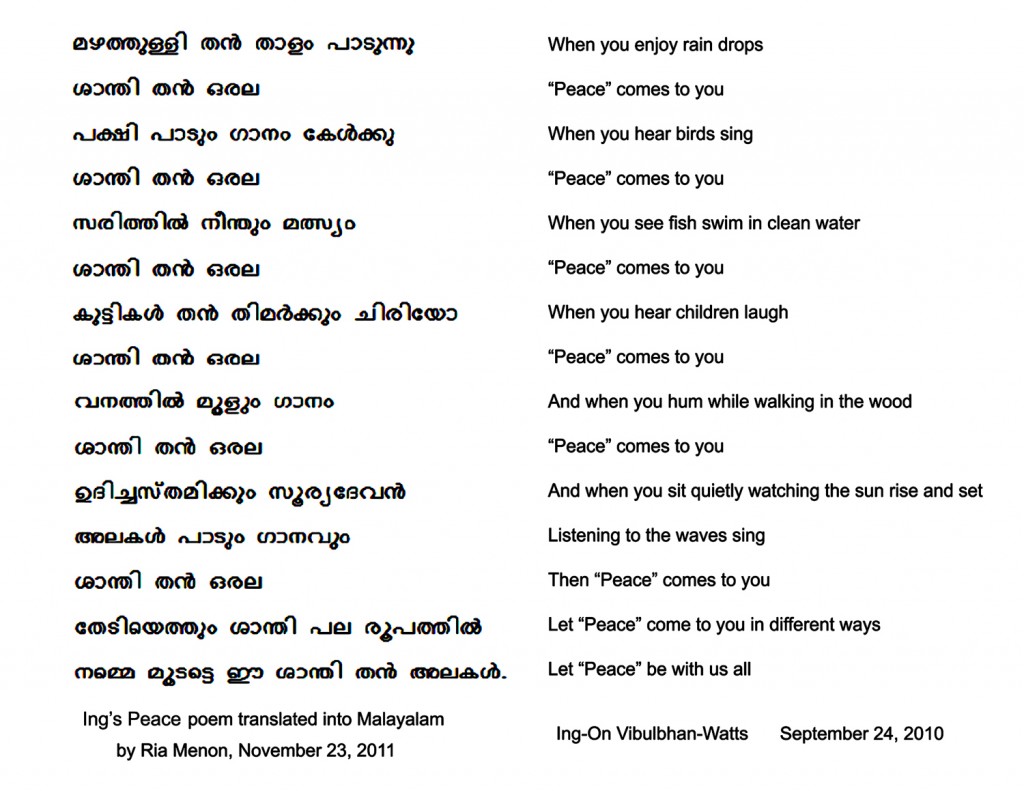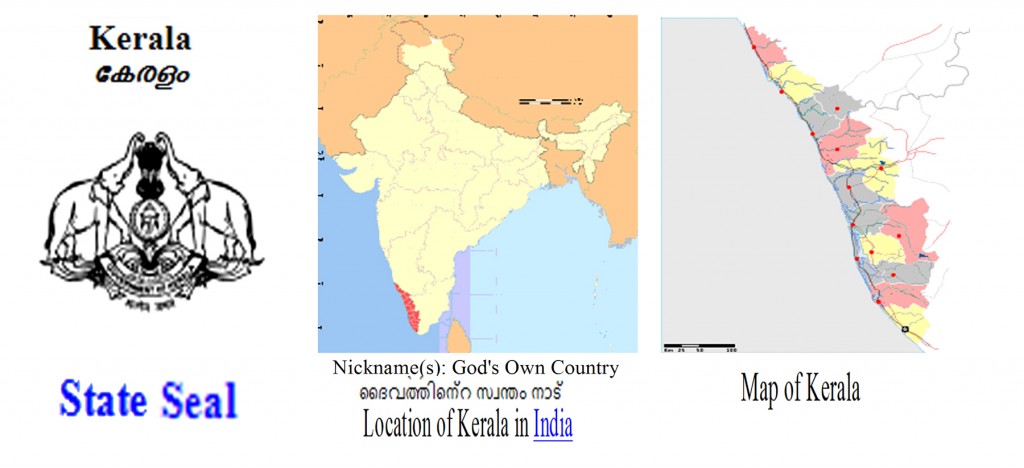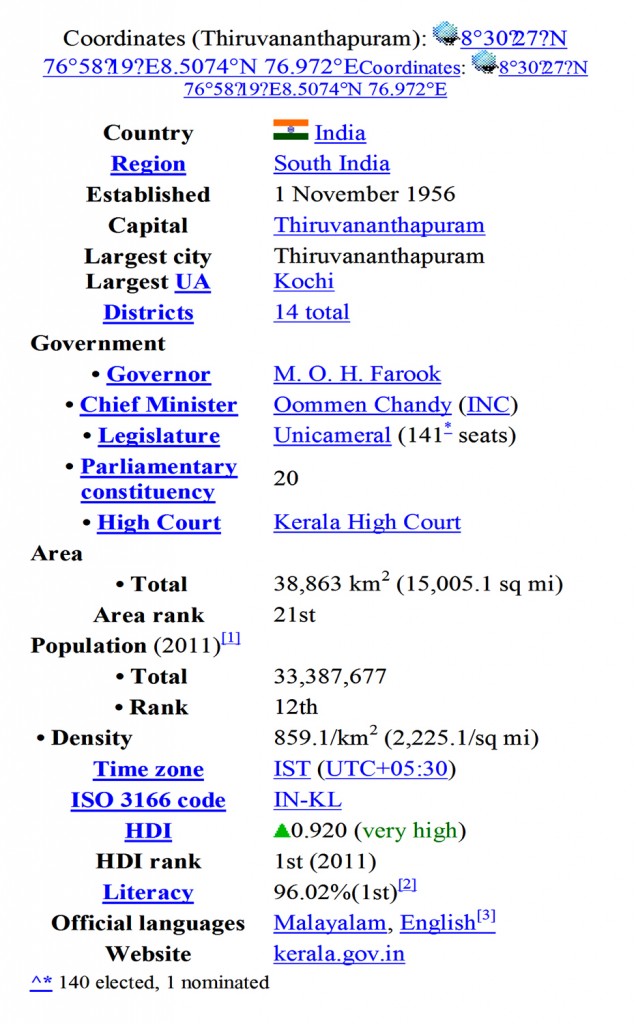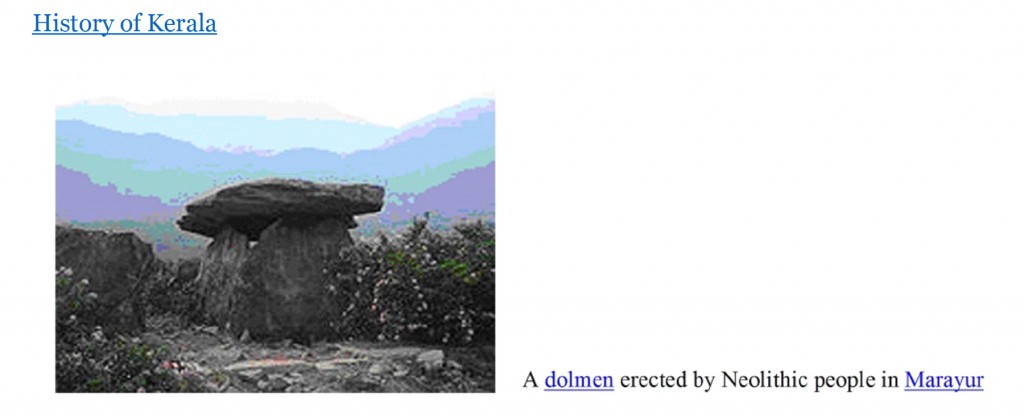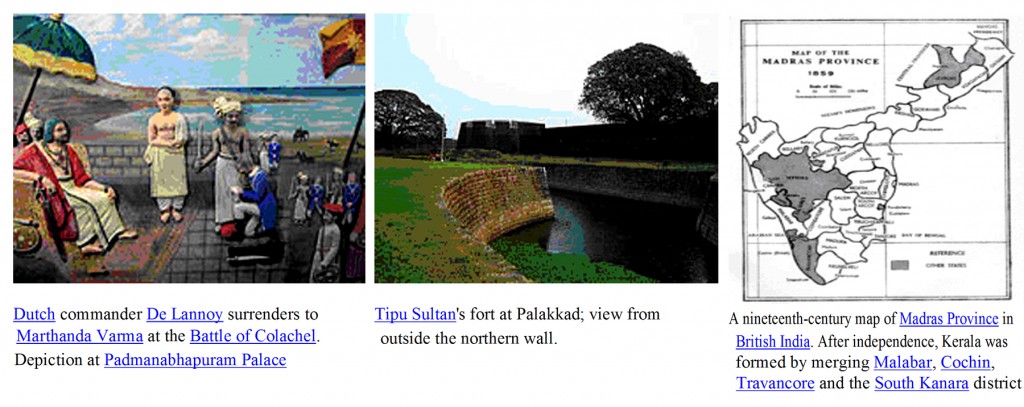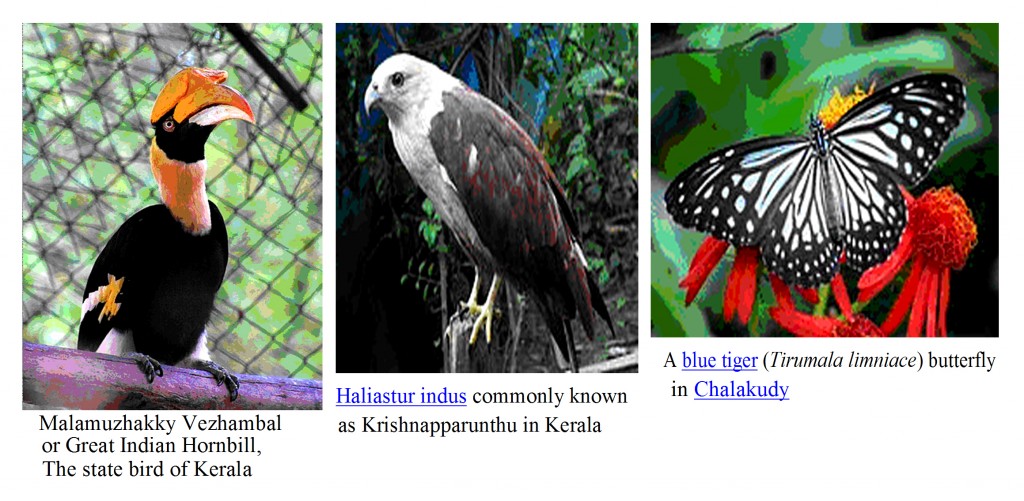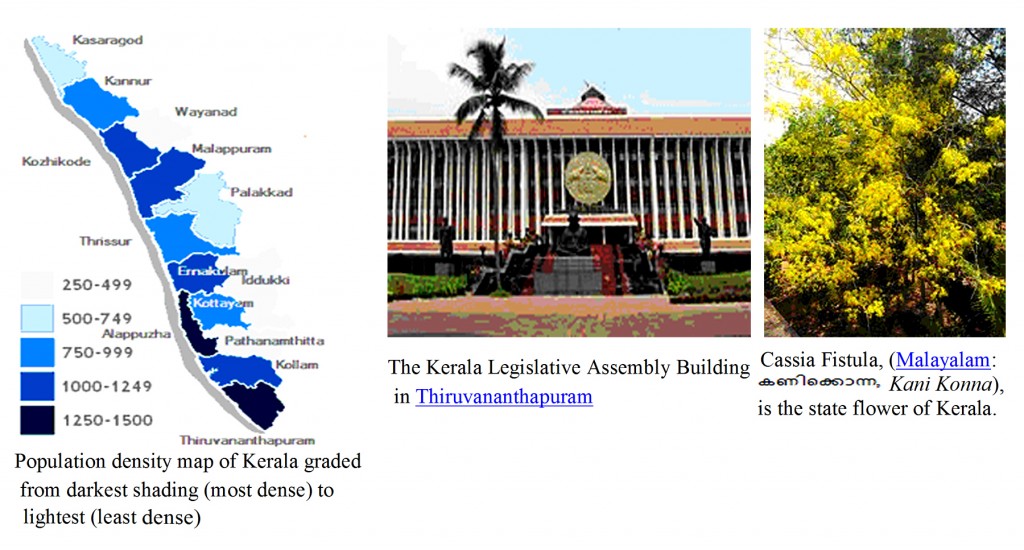Trip to Kerala, India
Thanks to Ria Menon who introduced me to Kerala. With the generosity of Wikipedia I was able to take a trip to a far away land that I had never known before, without going out of my house. I enjoyed studying the location, people, and the history of Kerala.
Ria Menon is one of John’s new pottery students. John told me that he enjoys having his pottery class and this passed fall session john had a new student. He said “My new student’s name is Ria. She is a very good student. This is her first class of making pottery but she is mastering the techniques very quickly. She is from India, and is a very nice person. You will like her.” I am glad John enjoys teaching his new student. John is fond of India especially Indian food. He loves Indian curry and tea. And I do like Indian food also. I am very anxious to meet her and after I met her I understand why John kept telling me about her. I am very glad to know her also. I introduced Ria to my Peace Project and Poem which is translated into twelve languages but I did not have any Indian languages. She was kind enough to translate my peace poem into her native language. The following is her translation in Malayalam and includes the English version of my poem:
“The translation is in Malayalam, my mother tongue. It is spoken in Kerala (meaning land of coconuts), a small state to the south-west ofIndia. Two interesting historical facts about the place…
(1) It is where Vasco Da Gama landed in his quest for a sea route to the East, thereby changing the course of history.
(2) It is the first place in the whole world where a communist government came to power through democratic elections.
Lots more interesting stuff here: https://en.wikipedia.org/wiki/Kerala”
Above is a portion of Ria’s email giving me information about her translation and about Kerala. I hope you enjoy taking a trip to Kerala from Wikipedia:
Kerala (help·info) or Keralam (Malayalam: ?????, K?ra?am) is an Indian state located on the Malabar coast of south-west India. It was created on 1 November 1956 by the States Reorganisation Act by combining various Malayalam speaking regions.
The state has an area of 38,863 km2 (15,005 sq mi) and is bordered by Karnataka to the north and northeast, Tamil Nadu to the south and southeast, and the Arabian Sea[note] on the west. The city of Thiruvananthapuram is the state capital. Kochi and Kozhikode are other major cities. According to a survey by The Economic Times, five out of ten best cities to live in India are located in Kerala.[4] Kerala is a popular tourist destination for its backwaters, yoga, Ayurvedic treatments[5] and tropical greenery.
Kerala has the highest Human Development Index[6][7] in India, comparable with that of first world nations but with a much lower per capita income.[8] The state has the highest literacy rate in India with 99 percent.[9] The state recently became and is currently the only one to have banking facilities in every village.[10] A survey conducted in 2005 by Transparency International ranked Kerala as the least corrupt state in the country.[11] Kerala has witnessed significant migration of its people, especially to the Persian Gulf countries during the Kerala Gulf boom and is heavily dependent on remittances from its large Malayali expatriate community.[12][13][14][15]
Pre-history of Kerala: Evidence of Kerala’s early human occupation includes Dolmens of the Neolithic era, in the Marayur area. They are locally known as “muniyara”, derived from muni (hermit or sage, and ara (dolmen).[21] Rock-engravings in the Edakkal Caves (in Wayanad) are thought to date from the early to Late Neolithic eras around 5000 B.C.[22][23][24] The use of a specific Indus script pictogram in these caves suggests some relationship with the Indus Valley Civilization during the late Bronze Age and early Iron age.[25]
Early history and culture, Kerala was a major spice exporter as early as 3,000 BCE, according to Sumerian Records.[26][27]
Kerala and Tamil Nadu once shared a common language and culture, within an area known as Tamilakam.[28] In the 1st century BCE, Tamil-speaking Dravidian Villavars[clarification needed] established the Chera Dynasty that ruled northern Kerala[29] from a capital at Vanchi. Southern Kerala was ruled by the Pandyan Kingdom, with a trading port variously identified by ancient Western sources as “Nelcynda” and “Neacyndi”[30] The Cheras had trading links with China, West Asia, Egypt and the Roman Empire. The value of Rome’s annual trade with India as a whole was estimated at no less than 50,000,000 sesterces;[31] contemporary Sangam literature describes Roman ships coming to Muziris in Kerala, laden with gold to exchange for pepper.[32] One of the earliest western traders to use the monsoon winds to reach Kerala may have been Eudoxus of Cyzicus, around 118 or 166 BCE, under the patronage of Ptolemy VIII, king of the Hellenistic Ptolemaic dynasty in Egypt. Kerala is identified on the Tabula Peutingeriana, the only known surviving map of the Roman cursus publicus.[33]
The Chera kings’ dependence on trade meant that merchants from West Asia and Southern Europeestablished coastal posts and settlements in Kerala.[34]:192–195, 303–307 The west Asian-semitic [35] Jewish, Christian, and Muslim immigrants[35] established Juda Mappila, Nasrani Mappila, and Muslim Mappila communities respectively.[35][36] The Jews first arrived in Kerala in 573 BC.[37][38] According to local Syriac Nasrani Christian tradition as well as the works of scholars and Eastern Christian writings, Thomas the Apostle visited Muziris in Kerala circa 52 CE to proselytize amongst Kerala’s Jewish settlements.[39][40] The first mosque, synagogue, and church inIndia were built in Kerala.
A later Chera Kingdom was established c. 800–1102, with the help of Arab spice merchants. This is also called the Kulasekhara dynasty, as it was founded by Kulasekhara Varman, a Vaishnavaite saint. Ay kings ruled southern Kerala, but by the 10th century the Ay kingdom declined and became a part of the Chera Kingdom.[41] A Keralite identity, distinct from the Tamils, became linguistically separate during this period.[42] The Kulasekhara dynasty came to an end by twelfth century, weakened by the invasions of Pandyas and Cholas.[32] In the absence of a strong central power, the state fractured into small principalities governed by Nair chieftains. From these, the kingdoms of Kochi, Venad, Kolathiri and Kozhikode Samuthiri emerged.
There were major revolts in Kerala against British rule in the 20th century, until Independencewas achieved. They include the 1921 Malabar Rebellion and the 1946 Punnapra-Vayalar uprising in Travancore.[47] Other actions by Kerala’s political and spiritual leaders[48] protested against social traditions such as untouchability, leading to the 1936 Temple Entry Proclamation that opened Hindu temples in Travancore to all castes; Malabar soon did likewise, and Cochin followed with a similar proclamation in 1948, after Independence. In the 1921 Moplah Rebellion, Mappila Muslims rioted against Hindu zamindars (see Zamindari system) and the British Raj.[49]
Post Independence: After British India was partitioned in 1947 into India and Pakistan, Travancore and Cochin joined the Union of India and on 1 July 1949 were merged to form Travancore-Cochin. On 1 January 1950 (Republic Day), Travancore-Cochin was recognised as a state. The Madras Presidency was organised to form Madras State in 1947.
On 1 November 1956, the state of Kerala was formed by the States Reorganisation Act merging the Malabar district, Travancore-Cochin (excluding four southern taluks, which were merged with Tamil Nadu), and the taluk of Kasargod, South Kanara.[50] In 1957, elections for the new Kerala Legislative Assembly were held, and a reformist, Communist-led government came to power, under E.M.S. Namboodiripad.[50]The Communist government initiated pioneering land reforms, leading to lowest levels of rural poverty in India.[51]
Kerala in religious traditions: The oldest of the surviving Hindu Puranas, the Matsya Purana, sets the story of the first of the incarnations of Lord Vishnu, the Matsya Avatar, and King Manu (King Satyavrata, mankind’s ancestor), among Kerala’s Malaya Mountains.[52][53][54][55]
The earliest Sanskrit text to mention Kerala by name is the Aitareya Aranyaka.[9]
The legendary king Mahabali is said to have ruled from Kerala in a reign of universal happiness and prosperity. On his passing away he was appointed ruler of the netherworld (Patalam) by Vamana, the fifth avatar of Lord Vishnu. There is a belief that, Once a year, during the Onam festival, he returns to Kerala.
Geography of Kerala is wedged between the Lakshadweep sea and the Western Ghats. Lying between north latitudes 8°18? and 12°48? and east longitudes 74°52? and 77°22?,[62][63] Kerala experiences the humid equatorial tropic climate. The state has a coast of length 590 km (370 mi)[64] and the width of the state varies between 35 and 120 km (22–75 miles). Geographically, Kerala can be divided into three climatically distinct regions: the eastern highlands (rugged and cool mountainous terrain), the central midlands (rolling hills), and the western lowlands (coastal plains). Located at the extreme southern tip of the Indian subcontinent, Kerala lies near the centre of the Indian tectonic plate; hence, most of the state is subject to comparatively little seismic and volcanic activity.[65] Pre-Cambrian and Pleistocene geological formations compose the bulk of Kerala’s terrain.
The eastern Kerala region consists of high mountains, gorges and deep-cut valleys immediately west of the Western Ghats’ rain shadow. Forty-one of Kerala’s west-flowing rivers, and three of its east-flowing ones originate in this region. The Western Ghats form a wall of mountains interrupted only near Palakkad, where the Palakkad Gap breaks through to provide access to the rest of India. The Western Ghats rises on average to 1,500 m (4920 ft) above sea level, while the highest peaks may reach to 2,500 m (8200 ft). Anamudi is the highest peak at an elevation of 2,695 metres (8,842 ft). Just west of the mountains lie the midland plains comprising central Kerala, dominated by rolling hills and valleys.[62] Generally ranging between elevations of 250–1,000 m (820–3300 ft), the eastern portions of the Nilgiri and Palni Hills include such formations as Agastya Mala and Anamala.
Kerala’s western coastal belt is relatively flat, and is criss-crossed by a network of interconnected brackish canals, lakes, estuaries, and rivers known as the Kerala Backwaters. Lake Vembanad, Kerala’s largest body of water, dominates the Backwaters; it lies between Alappuzha and Kochi and is more than 200 km2 (77 sq mi) in area. Around 8% of India’s waterways (measured by length) are found in Kerala.[66] The most important of Kerala’s forty-four rivers include the Periyar (244 km), the Bharathapuzha (209 km), the Pamba (176 km), the Chaliyar (169 km), the Kadalundipuzha River (130 km), the Valapattanam (129 km) and the Achankovil (128 km). The average length of the rivers of Kerala is 64 km. Many of the rivers are small and entirely fed by monsoon rains.[62] These conditions result in the nearly year-round water logging of such western regions as Kuttanad, 500 km² of which lies below sea level. As Kerala’s rivers are small and lack deltas, they are more prone to environmental factors. The rivers also face problems such as sand mining and pollution.[67] The state experiences several natural hazards such as landslides, floods, lightning and droughts. The state was also affected by the 2004 Indian Ocean Tsunami.
A catastrophic flood in Kerala in 1341 CE drastically modified its terrain and consequently affected its history.[68] The course of the river Periyar was changed, and the Arabian Sea receded several miles. The Kuttanad region became cultivable, and the Muziris (Kodungalloor) harbour became defunct. A new harbour was developed at Kochi.[69][70]
Climate: With 120–140 rainy days per year, Kerala has a wet and maritime tropical climate influenced by the seasonal heavy rains of the southwest summer monsoon.[71]:80 In eastern Kerala, a drier tropical wet and dry climate prevails. Kerala’s rainfall averages 3,107 mm (122 in.) annually. Some of Kerala’s drier lowland regions average only 1,250 mm (49 in.); the mountains of eastern Idukki district receive more than 5,000 mm (197 in.) of orographic precipitation, the highest in the state.
During summer, Kerala is prone to gale force winds, storm surges, cyclone-related torrential downpours, occasional droughts, and rises in sea level.[72]:26, 46, 52 The mean daily temperatures range from 19.8 °C to 36.7 °C.[62] Mean annual temperatures range from 25.0–27.5 °C in the coastal lowlands to 20.0–22.5 °C in the eastern highlands.[72]:65
Much of Kerala’s notable biodiversity is concentrated and protected in the Western Ghats. Almost a fourth of India’s 10,000 plant species are found in the state. Among the almost 4,000 flowering plant species (1,272 of which are endemic to Kerala and 159 threatened) are 900 species of medicinal plants.[73][74]:11
Its 9,400 km² of forests include tropical wet evergreen and semi-evergreen forests (lower and middle elevations—3,470 km²), tropical moist and dry deciduous forests (mid-elevations—4,100 km² and 100 km², respectively), and montane subtropical and temperate (shola) forests (highest elevations—100 km²). Altogether, 24% of Kerala is forested.[74]:12 Two of the world’s Ramsar Convention listed wetlands—Lake Sasthamkotta and the Vembanad-Kol wetlands—are in Kerala, as well as 1455.4 km² of the vast Nilgiri Biosphere Reserve. Subjected to extensive clearing for cultivation in the 20th century,[75]:6–7 much of the remaining forest cover is now protected from clearfelling. Kerala’s fauna are notable for their diversity and high rates of endemism: 102 species of mammals (56 of which are endemic), 453 species of birds, 202 species of freshwater fishes, 169 species of reptiles (139 of them endemic), and 89 species of amphibians (86 endemic).[73] These are threatened by extensive habitat destruction, including soil erosion, landslides, salinization, and resource extraction.[76]
Eastern Kerala’s windward mountains shelter tropical moist forests and tropical dry forests, which are common in the Western Ghats. Here, sonokeling (Dalbergia latifolia), anjili, mullumurikku (Erythrina), and Cassia number among the more than 1,000 species of trees in Kerala. Other plants include bamboo, wild black pepper, wild cardamom, the calamus rattan palm (a type of climbing palm), and aromatic vetiver grass (Vetiveria zizanioides).[74]:12 Living among them are such fauna as Indian Elephant (Elephas maximus indicus), Bengal Tiger, Indian Leopard (Panthera pardus fusca), Nilgiri Tahr, Common Palm Civet, and Grizzled Giant Squirrel.[74]:12, 174–175 Reptiles include the King Cobra (Ophiophagus hannah), viper, python, and Mugger Crocodile (Crocodylus palustris) . Kerala’s birds are legion—Malabar Trogon, the Great Hornbill, Kerala Laughingthrush, Darter, and Southern Hill Myna are several emblematic species. In lakes, wetlands, and waterways, fish such as kadu (stinging catfish) and Choottachi (Orange chromide—Etroplus maculatus) are found.[74]:163–165
State symbols of Kerala
Animal Elephant
Bird Great Indian Hornbill
Flower Cassia Fistula (Indian laburnum)
Tree Coconut
Fruit Jackfruit
Fish Pearl spot (karimeen)
Costume Mundum Neriyathum (women), Mundu (Men)
Language Malayalam
‹ The template below (Orissa symbols) is being considered for deletion. See templates for discussion to help reach a consensus.›
Kerala’s Government is based on rules and regulations determined by the Government of India. The State is governed via a parliamentary system of representative democracy; universal suffrage is granted to state residents. There are three branches of government.[clarification needed] The unicameral legislature, the Kerala Legislative Assembly, comprises elected members and special office bearers (the Speaker and Deputy Speaker) elected by the members from among themselves. Assembly meetings are presided over by the Speaker and in the Speaker’s absence, by the Deputy Speaker. Kerala has 140 Assembly constituencies.[77] The state sends 20 members to the Lok Sabha and 9 to the Rajya Sabha, the Indian Parliament‘s upper house.[78]
The Governor of Kerala is the constitutional head of state, and is appointed by the President of India.[79][80] The state’s 2005–2006 budget was 219 billion INR.[82] The state government’s tax revenues (excluding the shares from Union tax pool) amounted to 111,248 million INR in 2005, up from 63,599 million in 2000. Its non-tax revenues (excluding the shares from Union tax pool) of the Government of Kerala as assessed by the Indian Finance Commissions reached 10,809 million INR in 2005, nearly double the 6,847 million INR revenues of 2000.[83] However, Kerala’s high ratio of taxation to gross state domestic product (GSDP) has not alleviated chronic budget deficits and unsustainable levels of government debt, impacting social services.[84]
Kerala hosts two major political alliances: the United Democratic Front (India) (UDF—led by the Indian National Congress)and the Left Democratic Front (Kerala) (LDF—led by the Communist Party of India (Marxist) (CPI(M)). At present, the UDF is the ruling coalition in government; Oommen Chandy of the INC is the Chief Minister of Kerala and V.S. Achuthanandan of the LDF is the Chief Opposition leader. Strikes, protests and marches are ubiquitous in Kerala due to the comparatively strong presence of labour unions.[85][86]
Since independence, Kerala was managed as a democratic socialist welfare economy. Since the 1990s, liberalisation of the mixed economy allowed onerous Licence Raj restrictions against capitalism and foreign direct investment to be lightened, leading to economic expansion and job creation. In fiscal year 2007–2008, nominal gross state domestic product (GSDP) was 162,414.79 crore (US$30.86 billion).[87] Recent GSDP growth (9.2% in 2004–2005 and 7.4% in 2003–2004) has been robust compared to historical averages (2.3% annually in the 1980s and between 5.1%[88]:8 and 5.99%[89] in the 1990s).[88]:8 The state clocked 8.93% growth in enterprises from 1998 to 2005 compared with 4.80% nationally.[90] Relatively few such enterprises are major corporations or manufacturers.[72] Kerala’s Human Development Index rating is the highest in India.[91] This apparently paradoxical “Kerala phenomenon” or “Kerala model of development” of very high human development and not much high economic development results from the strong service sector.[72]:48[92]:1
Kerala’s economy depends on emigrants working in foreign countries (mainly in the Persian Gulf countries such as United Arab Emirates or Saudi Arabia) and remittances annually contribute more than a fifth of GSDP.[12][13][14] As of 2008, the Gulf countries altogether have a Keralite population of more than 2.5 million, who send home annually a sum of USD 6.81 billion,[93] which is more than 15.13% of Remittance to India in 2008.
The service sector (including tourism, public administration, banking and finance, transportation, and communications—63.8% of GSDP in 2002–2003) and the agricultural and fishing industries (together 17.2% of GSDP) dominate the economy.[89][94] Nearly half of Kerala’s people are dependent on agriculture alone for income.[95] Some 600 varieties[74]:5 of rice (Kerala’s most important staple food and cereal crop)[96]:5 are harvested from 3105.21 km² (a decline from 5883.4 km² in 1990)[96]:5 of paddy fields; 688,859 tonnes are produced per annum.[95] Other key crops include coconut (899,198 ha), tea, coffee (23% of Indian production,[97]:13 or 57,000 tonnes[97]:6–7), rubber, cashews, and spices—including pepper, cardamom, vanilla, cinnamon, and nutmeg. Around 1.050 million fishermen haul an annual catch of 668,000 tonnes (1999–2000 estimate); 222 fishing villages are strung along the 590 km coast. Another 113 fishing villages dot the hinterland.
Kerala’s coastal belt of Karunagappally is known for high background radiation from thorium-containing monazite sand. In coastal panchayats, median outdoor radiation levels are more than 4 mGy/yr and, in certain locations on the coast, it is as high as 70 mGy/yr.[98]
Traditional industries manufacturing such items as coir, handlooms, and handicrafts employ around one million people. Around 180,000 small-scale industries employ around 909,859 Keralites; 511 medium and large scale manufacturing firms are located in Kerala. A small mining sector (0.3% of GSDP)[94] involves extraction of ilmenite, kaolin, bauxite, silica, quartz, rutile, zircon, and sillimanite.[95] Home gardens and animal husbandry also provide work for hundreds of thousands of people. Other major sectors are tourism, manufacturing, and business process outsourcing. As of March 2002, Kerala’s banking sector comprised 3341 local branches; each branch served 10,000 persons, lower than the national average of 16,000; the state has the third-highest bank penetration among Indian states.[99] On 1 October 2011, Kerala became the first state in the country to have banking facility in every village.[100] Unemployment in 2007 was estimated at 9.4%;[101] underemployment, low employability of youths, and a 13.5% female participation rate are chronic issues,[102]:5, 13 [103]as is the practice of Nokku kooli, ‘wages for looking on’.[104] By 1999–2000, the rural and urban poverty rates dropped to 10.0% and 9.6% respectively.[105]
The state treasury has suffered loss of thousands of millions of rupees thanks to the state staging over 100 hartals annually in recent times. A record total of 223 hartals were observed in 2006, resulting in a revenue loss of over 2000 crore.[106]
Transport: The length of the National Highway 47 (India) through Kerala is 416.8 km.[108] NH 49 (Kochi – Dhanushkodi), NH 208 (Kollam – Thirumangalam), NH 212 (Kozhikode – Mysore), NH 213 (Kozhikode – Palakkad), NH 220 (Kollam – theni) are the other national highways serving the state of Kerala.[109]
The Department of Public Works is responsible for maintaining and expanding the state highways system and major district roads.The Kerala State Transport Project (KSTP), which includes the GIS-based Road Information and Management Project (RIMS), is responsible for maintaining and expanding the state highways in Kerala; it also oversees few major district roads.[110][111]
Traffic in Kerala has been growing at a rate of 10–11% every year, resulting in high traffic and pressure on the roads. Kerala’s road density is nearly four times the national average, reflecting the state’s high population density. Kerala’s annual total of road accidents is among the nation’s highest. The accidents are mainly result of the narrow roads and irresponsible driving. [112]
Kerala has major international airports in Thiruvananthapuram, Kochiand Kozhikode. A fourth international airport is proposed at Kannur.[113] Thiruvananthapuram’s Trivandrum International Airport is the first International airport in an Indian non-metro city. The Cochin International Airport is the busiest and largest in the state, and was the first Indian airport to be incorporated as a public limited company; funded by nearly 10,000 Non Resident Indians from 30 countries.[114]
Inland Water Transport in Kerala: Kerala, with numerous backwaters, is one of the States in India, where waterways are successfully used for commercial Inland Water Transport. The transportation is mainly done with country craft and passenger vessels. There are 41 navigable rivers in Kerala. The total length of the Inland Waterways in the State is 1687 km. The main constraints to the expansion of Inland Water transport in the State are lack of depth in the waterway caused by silting, lack of maintenance of navigation system and bank protection, accelerated growth of the water hyacinth, lack of modern inland craft terminals and cargo handling system. A 205 km canal, National Waterway 3, runs between Kottapuram and Kochi.[115]
Demographics: The 31.8 million[116] Keralites are predominantly of Malayali descent, while the rest is mostly made up of Jewish and Arab elements in both culture and ancestry. Kerala’s 321,000 indigenous tribal Adivasis, 1.10% of the population, are concentrated in the east.[117]:10–12 Malayalam is Kerala’s official language; Konkani, Tamil, Tulu, Kannada, Hindi and various Adivasi (Tribal) languages are also spoken by ethnic minorities especially in the south-western region.
Kerala is home to 3.44% of India’s population; at 819 persons per km², its land is nearly three times as densely settled as the rest of India, which is at a population density of 325 persons per km².[120] Kerala’s rate of population growth is India’s lowest,[121] and Kerala’s decadal growth (9.42% in 2001) is less than half the all-India average of 21.34%.[122] Whereas Kerala’s population more than doubled between 1951 and 1991 by adding 15.6 million people to reach 29.1 million residents in 1991, the population stood at less than 32 million by 2001. Kerala’s coastal regions are the most densely settled, leaving the eastern hills and mountains comparatively sparsely populated.[62]
Females comprise 51.42% of the population; males form the remaining 48.58% of the population.[123]:26 Kerala’s principal religions are Hinduism (56.2%), Islam (24.70%), and Christianity (19.00%).[124] In comparison with the rest of India, Kerala experiences relatively little sectarianism.[125]
| Religion in Kerala[124] | ||||
| Religion | Percent | |||
| Hinduism | 56.2% | |||
| Islam | 24.7% | |||
| Christianity | 19.0% | |||
| Others | 1.1% | |||
Jainism has a considerable following in the Wayanad district. Buddhism was dominant at the time of Ashoka the Great but vanished by the 8th century CE.[135]
Kerala government states gender relations are among the most equitable in India[Need quotation to verify],[136] despite discrepancies among low caste men and women.[137]:1 Certain Hindu communities such as the Nairs, some Ezhavas and the Muslims around North Malabar used to follow a traditional matrilineal system known as marumakkathayam, although this practice ended in the years after Indian independence. Other Muslims, Christians, and some Hindu castes such as the Namboothiris and the Ezhavas follow makkathayam, a patrilineal system.[138] Owing to the former matrilineal system, women in Kerala enjoy a high social status.[139]
Kerala’s human development indices— primary level education, health care and elimination of poverty—are among the best in India. According to a 2005–2006 national survey, Kerala has one of the highest literacy rates (94.59%) among Indian states[9] and life expectancy (74 years) was among the highest in India in 2011.[140] Kerala’s rural poverty rate fell from 69% (1970–1971) to 19% (1993–1994); the overall (urban and rural) rate fell 36% between the 1970s and 1980s.[141] By 1999–2000, the rural and urban poverty rates dropped to 10.0% and 9.6% respectively.[105] These changes stem largely from efforts begun in the late 19th century by the kingdoms of Cochin and Travancore to boost social welfare.[142][143] This focus was maintained by Kerala’s post-independence government.[72][91]:48
Kerala has the highest life expectancy in the country which is nearly 75 years and 78 years respectively for males and females. The life expectancy of Kerala is similar to developed nations in the world that shows the facilities for treatment and health. Kerala’s healthcare system has garnered international acclaim. The United Nations Children’s Fund (UNICEF) and the World Health Organisation designated Kerala the world’s first “baby-friendly state” because of its effective promotion of breast-feeding over formulas[145] For example, more than 95% of Keralite births are hospital-delivered.[146]:6 Aside from ayurveda (both elite and popular forms),[147]:13 siddha, and many endangered and endemic modes of traditional medicine, including kalari, marmachikitsa and vishavaidyam, are practiced. These propagate via gurukula discipleship,[147]:5–6 and comprise a fusion of both medicinal and supernatural treatments,[147]:15 and are partly responsible for drawing increasing numbers of medical tourists.
A steadily aging population (11.2% of Keralites are over age 60[91]) and low birthrate[148] (18 per 1,000)[149] make Kerala one of the few regions in the developing world to have undergone the “demographic transition” characteristic of such developed nations as Canada, Japan, and Norway.[92]:1 In 1991, Kerala’s total fertility rate (children born per women) was the lowest in India. Hindus had a TFR of 1.66, Christians 1.78, and Muslims 2.97.[150] Kerala’s female-to-male ratio (1.058) is significantly higher than that of the rest of India.[92][151]:2 sub-replacement fertility level and infant mortality rate is lower compared to other states (estimated at 12[72][149]:49 to 14[152]:5 deaths per 1,000 live births).
However, Kerala’s morbidity rate is higher than that of any other Indian state—118 (rural Keralites) and 88 (urban) per 1,000 people. The corresponding all India figures are 55 and 54 per 1,000, respectively.[152]:5Yet this is likely explained by the fact that, as mentioned above, Kerala has a higher ratio of senior citizens than India. Kerala’s 13.3% prevalence of low birth weight is substantially higher than that of First World nations.[149] Outbreaks of water-borne diseases such as diarrhoea, dysentery, hepatitis, and typhoid among the more than 50% of Keralites who rely on 3 million water wells is a problem worsened by the widespread lack of sewers.[153]:5–7
Education in Kerala: Kerala has highest literacy among the states of India. State topped the Education Development Index (EDI) among 21 major states in India in year 2006–2007.[154]
More than 94% of the rural population has access to primary school within 1 km, while 98% of population benefits one school within a distance of 2 km.[citation needed] An upper primary school within a distance of 3 km is available for more than 96% of the people, whose 98% benefit the facility for secondary education within 8 km. The access for rural students to higher educational institutions in cities is facilitated by widely subsidised transport fares.[citation needed]
Kerala’s educational system has been developed by institutions owned or aided by the government.In the educational system prevailed in the state schooling is for 10 years which is subdivided into lower primary, upper primary and high school, After 10 years of secondary schooling, students typically enroll in Higher Secondary Schooling in one of the three major streams—liberal arts, commerce or science.[citation needed] Upon completing the required coursework, students can enroll in general or professional under graduate programmes.
Schools and colleges are run by the government, private trusts, or individuals. Many of the schools owned by private sector are aided by government. Majority of the public schools are affiliated to Kerala State Education Board. Other familiar educational boards are Indian Certificate of Secondary Education (ICSE), the Central Board for Secondary Education (CBSE), or the National Institute of Open Schooling (NIOS). English is the language of instruction in most self financing schools, while government and government aided schools offer English or Malayalam[citation needed].
No fees (or a nominal fees) are required in schools run by or aided by government. Fees concerning the higher and technical education are very low; the ratio of recovery of government’s revenue expenditure was 2.6% in 2006–2007.[155] However, the lacking of fees or low fees does not imply low educational cost, as the students incur other costs of several types (examination fees, special fees, material costs, clothing travelling, private tuition). In fact, according to the 61st round of National Sample Survey (2004–2005), per capita spending on education by the rural households resulted to be more than twice the national average ( 41 for Kerala, 18 for India).Urban India spending, on the contrary, resulted to be greater than Kerala’s ( 74 for India, 66 for Kerala). However, the survey reveals that the rural-urban difference in expenditure on education by households was much less in Kerala than in the rest of India.[156]
The few universities in Kerala are Kannur University, Mahatma Gandhi University, University of Calicut, University of Kerala, Cochin University of Science and Technology, Kerala Agricultural University, Sree Sankaracharya University of Sanskrit.[157] Premiere educational institutions in Kerala are Indian Institute of Management Kozhikode, one of the thirteen Indian Institutes of Management, National Institute of Technology Calicut (NITC), Indian Institute of Space Science and Technology (IIST). Kerala also has a National law school which is known as the National University of Advanced Legal Studies.
A widespread Arabic educational system has also become a channel for employment in the Middle East in modern times.[158] Originating in 8th century madrasahs for primary children, Islamic and Arabic schooling was patronized and funded by the British colonial government. Today, the system of Islamic and Arabic primary education has grown and further integrated with government administration. In 2005, an estimated 6,000 Muslim Arabic teachers taught in Kerala government schools, with over 500,000 Muslim students.[159]
The Kerala school of astronomy and mathematics flourished between the 14th and 16th centuries. In attempting to solve astronomical problems, the Kerala school independently created a number of important mathematics concepts including results—series expansion for trigonometric functions.
Arts of Kerala and Culture of Kerala
Kerala’s culture is derived from both a Tamil-heritage region known as Tamilakam and southern coastal Karnataka. Later, Kerala’s culture was elaborated upon through centuries of contact with neighboring and overseas cultures.[160] Native performing arts include koodiyattom (a 2000-year-old Sanskrit theatre tradition,[161] officially recognised by UNESCO as a Masterpiece of the Oral and Intangible Heritage of Humanity[162]), kathakali—from katha (“story”) and kali (“performance”)—and its offshoot Kerala natanam, Kaliyattam -(North Malabar special), koothu (akin to stand-up comedy), mohiniaattam (“dance of the enchantress”), Theyyam, thullal NS padayani. Kathakali and Mohiniattam are widely recognized Indian Classical Dance traditions from Kerala.
Other forms of art are more religious or tribal in nature. These include chavittu nadakom and oppana which combines dance, rhythmic hand clapping, and ishal vocalisations. Margam Kali is a traditional group dance form traceable back to 17th century, originally performed during Syrian Christian festivals.[163] However, many of these art forms are largely performed for tourists or at youth festivals, and are not as popular among most Keralites. Contemporary art and performance styles including those employing mimicry and parody are more popular.[citation needed]
Kerala’s music also has ancient[weasel words] roots. Carnatic music dominates Keralite traditional music. This was the result of Swathi Thirunal Rama Varma‘s popularisation of the genre in the 19th century.[164][165] Raga-based renditions known as sopanam accompany kathakali performances. Melam (including the paandi and panchari variants) is a more percussive style of music; it is performed at Kshetram centered festivals using the chenda. Melam ensembles comprise up to 150 musicians, and performances may last up to four hours. Panchavadyam is a different form of percussion ensemble, in which up to 100 artists use five types of percussion instrument. Kerala has various styles of folk and tribal music. The popular music of Kerala is dominated by the filmi music of Indian cinema. Kerala’s visual arts range from traditional murals to the works of Raja Ravi Varma, the state’s most renowned painter.
Elephants are an integral part of daily life in Kerala.[citation needed] Indian elephants are loved, revered, groomed and given a prestigious place in the state’s culture. They are often referred to as[by whom?] the ‘sons of the sahya.’ Elephant is the state animal of Kerala and is featured on the emblem of the Government of Kerala.
Malayalam literature is medieval in origin and includes such figures as the 14th century Niranam poets (Madhava Panikkar, Sankara Panikkar and Rama Panikkar), and the 17th century poet Thunchaththu Ezhuthachan whose works mark the dawn of both modern Malayalam language and indigenous Keralite poetry. Paremmakkal Thoma Kathanar and Kerala Varma Valiakoi Thampuran are noted for their contribution to Malayalam prose. The “triumvirate of poets” (Kavithrayam), Kumaran Asan, Vallathol Narayana Menon, and Ulloor S. Parameswara Iyer, are recognised for moving Keralite poetry away from archaic sophistry and metaphysics, and towards a more lyrical mode.
Media in Kerala: The National Family Health Survey – 3, conducted in 2007 ranked Kerala as a state with the highest media exposure in India. Dozens of newspapers are published in Kerala, in nine major languages,[170] but principally Malayalam and English. The most widely circulating Malayalam-language newspapers are Malayala Manorama, Mathrubhumi, Madhyamam, Mangalam, Chandrika, Deepika, Kerala Kaumudi and Deshabhimani. Major Malayalam periodicals include Mathrubhumi, India Today Malayalam, Madhyamam weekly, Grihalakshmi, Vanitha, |Dhanam, Chithrabhumi, and Bhashaposhini.
Doordarshan is the state-owned television broadcaster. Multi system operators provide a mix of Malayalam, English and international channels via cable television. The major Malayalam television channels are Asianet, Surya TV, Mazhavil Manorama,Indiavision, Kairali TV, Manorama News, Amrita TV, Reporter,Jaihind,and Jeevan TV. All India Radio, the national radio service, reaches much of Kerala via its Thiruvananthapuram, Kochi, Thrissur, Alappuzha, Kozhikode and Kannur Malayalam-language broadcasts. Television serials, reality shows and the Internet have become a major source of entertainment and information for the people of Kerala. A Malayalam version of Google News was launched in September 2008.[171] Regardless, Keralites maintain high rates[quantify] of newspaper and magazine subscriptions. A sizeable “people’s science” movement has taken root in the state, and such activities as writers’ cooperatives are becoming increasingly common.[92][172]:2
Malayalam films are known for their realistic portrayal of characters and being socially oriented[examples needed] without giving a lot of importance to glitz and glamour[further explanation needed]. Movies produced in Hindi, Tamil and English (Made inHollywood) are popular among
Sports in Kerala: The Jawaharlal Nehru Stadium in Kochi is one of the largest multi-use stadiums in India several ancient ritualised arts are Keralite in origin. These include kalaripayattu—kalari (“place”, “threshing floor”, or “battlefield”) and payattu (“exercise” or “practice”). Among the world’s oldest martial arts, oral tradition attributes kalaripayattu’s emergence to Parasurama.[176] Other ritual arts include theyyam and poorakkali.
Cricket and football are the most popular sports in the state.[177] Kochi Tuskers Kerala is the franchise cricket team that plays in the Indian Premier League (IPL). Two Kerala Ranji Trophy players gained test selection in recent years. Sreesanth has represented India since 2005.[178] Among other Keralite cricketers is Tinu Yohannan, son of Olympic long jumper T. C. Yohannan.[179][180][181] Notable Kerala footballers include I. M. Vijayan, C. V. Pappachan, V. P. Sathyan, and Jo Paul Ancheri.[182][183]
Other popular sports include badminton, volleyball and kabaddi. Among Kerala athletes are P. T. Usha, T. C. Yohannan, Suresh Babu, Shiny Wilson, K. M. Beenamol, M. D. Valsamma and Anju Bobby George. Volleyball is another popular sport[citation needed] and is often played on makeshift courts on sandy beaches along the coast. Jimmy George was a notable Indian volleyball player, rated in his prime as among the world’s ten best players.[184]
Tourism in Kerala: Kerala is situated on the lush and tropical Malabar Coast. Kerala is one of the popular tourist destinations in India. Its unique[peacock term] culture and traditions, coupled with its varied demographics, has made Kerala one of the most popular tourist destinations in the world. National Geographic‘s Traveller magazine names Kerala as one of the “ten paradises of the world” and “50 must see destinations of a lifetime”. Travel and Leisure names Kerala as “One of the 100 great trips for the 21st century”.[185][186]
Until the early 1980s, Kerala was a relatively unknown destination;[187] most tourist circuits focused on North India. Aggressive marketing campaigns launched by the Kerala Tourism Development Corporation, the government agency that oversees tourism prospects of the state, laid the foundation for the growth of the tourism industry.[citation needed] In the decades[which?] that followed, Kerala’s tourism industry was able to transform the state into one of the niche holiday destinations in India. The tagline Kerala- God’s Own Country has been widely used in Kerala’s tourism promotions and soon became synonymous[peacock term] with the state. In 2006, Kerala attracted 8.5 million tourist arrivals, an increase of 23.68% over the previous year, making the state one of the fastest-growing destinations in the world.[188]
The state’s tourism industry is a major contributor to the state’s economy which is currently growing at a rate of 13.31%.[189]
Kerala is known for its ecotourism initiatives. Kerala was the first state in India to make tourism an industry.[190][191] The most popular tourist attractions in the state are beaches, backwaters and hill stations. These include the beaches at Kovalam, Cherai, Varkala, Kappad, Muzhappilangad and Bekal; the hill stations of Munnar, Wayanad, Wagamon, Peermade, Nelliampathi and Ponmudi; and national parks and wildlife sanctuaries at Periyar, Muthanga Wildlife Sanctuary and Eravikulam National Park. The “backwaters” is an extensive network of interlocking rivers, lakes, and canals that center around Alleppey, Kumarakom, Kollam and Punnamada (where the annual Nehru Trophy Boat Race is held in August). Heritage sites, such as the Padmanabhapuram Palace and the Mattancherry Palace, are also visited. Cities such as Thiruvananthapuram, Kochi and Kozhikode are popular centres for their shopping and traditional theatrical performances respectively. During early summer, the Thrissur Pooram is conducted, attracting foreign tourists who are largely drawn by the festival’s elephants and celebrants.[192] The main pilgrim tourist spots of Kerala are Sabarimala Temple, Padmanabhaswamy Temple (Thiruvananthapuram), Padanilam Parabrahma Temple(Mavelikkara), Chettikulangara Temple, Vadakumnathan Temple, Guruvayoor Temple, Sarkara Devi Temple, Malayattor Church and Parumala Church.
Link to Ing’s Peace Poem Translated into Yoruba-Nigeria-Togo_Benin page:
https://ingpeaceproject.com/ing-peace-project/peace-poem-yoruba-nigeria-togo-benin/
